Python中NumPy的arange()函数:创建等差数列数组的强大工具
NumPy是Python中用于科学计算的核心库之一,它提供了大量用于处理多维数组和矩阵的高性能工具。在NumPy中,arange()函数是一个非常实用的工具,用于创建等差数列数组。本文将深入探讨numpy.arange()函数的用法、特性以及在实际编程中的应用。
1. numpy.arange()函数简介
numpy.arange()函数是NumPy库中的一个重要函数,用于创建一个等差数列的一维数组。它的基本语法如下:
numpy.arange([start,] stop[, step,], dtype=None)
其中:
– start:序列的起始值,默认为0
– stop:序列的结束值(不包含)
– step:序列中相邻元素之间的步长,默认为1
– dtype:数组中元素的数据类型,默认情况下,NumPy会自动推断
让我们通过一个简单的例子来了解arange()函数的基本用法:
import numpy as np
# 创建一个从0到5(不包含5)的数组
arr = np.arange(5)
print("numpyarray.com example:", arr)
Output:

这个例子将创建一个包含[0, 1, 2, 3, 4]的数组。
2. 指定起始值和结束值
arange()函数允许我们指定序列的起始值和结束值。这在创建特定范围的数组时非常有用。
import numpy as np
# 创建一个从2到10(不包含10)的数组
arr = np.arange(2, 10)
print("numpyarray.com example:", arr)
Output:

这个例子将创建一个包含[2, 3, 4, 5, 6, 7, 8, 9]的数组。
3. 使用步长参数
step参数允许我们控制数组中相邻元素之间的间隔。这在创建非连续的序列时特别有用。
import numpy as np
# 创建一个从1到20,步长为2的数组
arr = np.arange(1, 20, 2)
print("numpyarray.com example:", arr)
Output:

这个例子将创建一个包含[1, 3, 5, 7, 9, 11, 13, 15, 17, 19]的数组。
4. 使用负步长
arange()函数也支持使用负步长,这允许我们创建递减的序列。
import numpy as np
# 创建一个从10到1(不包含1),步长为-1的数组
arr = np.arange(10, 0, -1)
print("numpyarray.com example:", arr)
Output:

这个例子将创建一个包含[10, 9, 8, 7, 6, 5, 4, 3, 2]的数组。
5. 使用浮点数步长
arange()函数不仅支持整数步长,还支持浮点数步长。这在创建精确的数值序列时非常有用。
import numpy as np
# 创建一个从0到1,步长为0.1的数组
arr = np.arange(0, 1.1, 0.1)
print("numpyarray.com example:", arr)
Output:

这个例子将创建一个包含[0., 0.1, 0.2, 0.3, 0.4, 0.5, 0.6, 0.7, 0.8, 0.9, 1.]的数组。
6. 指定数据类型
arange()函数允许我们通过dtype参数指定数组元素的数据类型。这在需要特定数据类型的场景中非常有用。
import numpy as np
# 创建一个从0到5的浮点数数组
arr = np.arange(6, dtype=float)
print("numpyarray.com example:", arr)
Output:

这个例子将创建一个包含[0., 1., 2., 3., 4., 5.]的浮点数数组。
7. 处理浮点数精度问题
使用浮点数时,可能会遇到精度问题。arange()函数在处理浮点数时也不例外。
import numpy as np
# 创建一个从0到1,步长为0.1的数组
arr = np.arange(0, 1, 0.1)
print("numpyarray.com example:", arr)
print("Length:", len(arr))
Output:

这个例子可能会创建一个长度为9或10的数组,这是由于浮点数精度限制造成的。为了避免这种情况,可以考虑使用np.linspace()函数。
8. 结合reshape()函数使用
arange()函数通常与reshape()函数结合使用,以创建多维数组。
import numpy as np
# 创建一个3x4的二维数组
arr = np.arange(12).reshape(3, 4)
print("numpyarray.com example:")
print(arr)
Output:
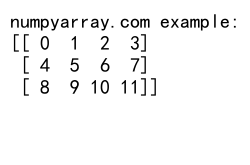
这个例子将创建一个3行4列的二维数组,包含从0到11的整数。
9. 创建日期范围
arange()函数结合NumPy的日期时间功能,可以用来创建日期范围。
import numpy as np
# 创建一个日期范围
start = np.datetime64('2023-01-01')
end = np.datetime64('2023-01-10')
date_range = np.arange(start, end, dtype='datetime64[D]')
print("numpyarray.com example:", date_range)
Output:

这个例子将创建一个包含2023年1月1日到2023年1月9日的日期数组。
10. 在数学计算中的应用
arange()函数在数学计算中非常有用,特别是在创建函数的输入值时。
import numpy as np
import matplotlib.pyplot as plt
# 创建x值的范围
x = np.arange(0, 10, 0.1)
# 计算y值
y = np.sin(x)
# 绘制图形
plt.plot(x, y)
plt.title('numpyarray.com example: Sin function')
plt.show()
Output:
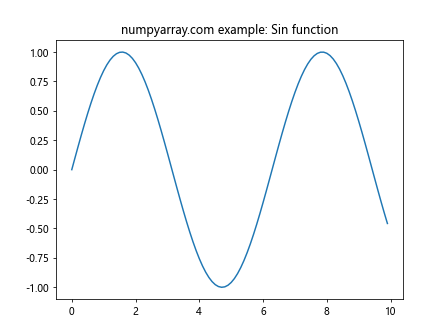
这个例子创建了一个正弦函数的图形,x值范围从0到10,步长为0.1。
11. 在机器学习中的应用
在机器学习中,arange()函数常用于创建特征或标签。
import numpy as np
from sklearn.preprocessing import StandardScaler
# 创建一个特征数组
features = np.arange(100).reshape(-1, 1)
# 标准化特征
scaler = StandardScaler()
scaled_features = scaler.fit_transform(features)
print("numpyarray.com example:")
print(scaled_features[:5]) # 打印前5个标准化后的特征
Output:
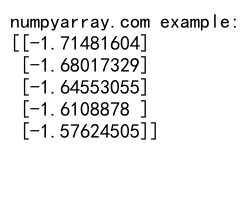
这个例子创建了一个包含100个值的特征数组,然后使用StandardScaler对其进行标准化。
12. 在图像处理中的应用
arange()函数在图像处理中也有广泛的应用,例如创建图像坐标。
import numpy as np
import matplotlib.pyplot as plt
# 创建一个10x10的网格
x = np.arange(10)
y = np.arange(10)
xx, yy = np.meshgrid(x, y)
# 创建一个简单的图像
image = xx * yy
# 显示图像
plt.imshow(image, cmap='viridis')
plt.title('numpyarray.com example: Simple image')
plt.colorbar()
plt.show()
Output:
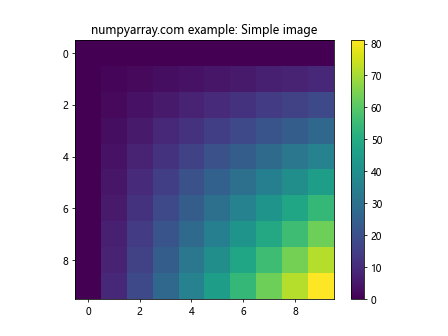
这个例子创建了一个简单的10×10图像,其中每个像素的值是其x和y坐标的乘积。
13. 在信号处理中的应用
arange()函数在信号处理中也很常用,例如创建时间序列。
import numpy as np
import matplotlib.pyplot as plt
# 创建时间序列
t = np.arange(0, 1, 0.01)
# 创建信号
signal = np.sin(2 * np.pi * 10 * t) + 0.5 * np.random.randn(len(t))
# 绘制信号
plt.plot(t, signal)
plt.title('numpyarray.com example: Noisy Sine Wave')
plt.xlabel('Time')
plt.ylabel('Amplitude')
plt.show()
Output:
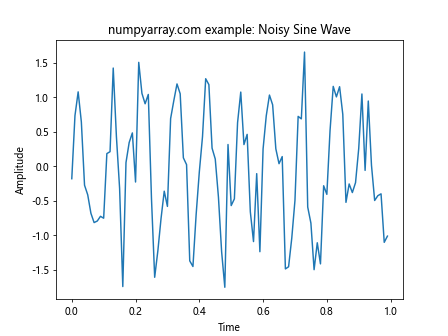
这个例子创建了一个带有噪声的正弦波信号。
14. 在金融分析中的应用
arange()函数在金融分析中也有应用,例如创建时间序列数据。
import numpy as np
import pandas as pd
# 创建日期范围
dates = pd.date_range(start='2023-01-01', end='2023-12-31', freq='D')
# 创建随机股票价格
prices = 100 + np.cumsum(np.random.randn(len(dates)) * 0.5)
# 创建DataFrame
df = pd.DataFrame({'Date': dates, 'Price': prices})
print("numpyarray.com example:")
print(df.head())
Output:
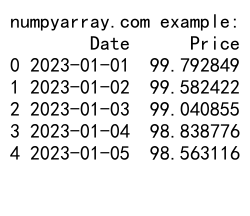
这个例子创建了一个包含一年的每日股票价格的DataFrame。
15. 在物理模拟中的应用
arange()函数在物理模拟中也很有用,例如模拟抛物线运动。
import numpy as np
import matplotlib.pyplot as plt
# 设置参数
g = 9.8 # 重力加速度
v0 = 20 # 初始速度
theta = np.pi/4 # 发射角度
# 创建时间序列
t = np.arange(0, 5, 0.1)
# 计算x和y坐标
x = v0 * np.cos(theta) * t
y = v0 * np.sin(theta) * t - 0.5 * g * t**2
# 绘制抛物线
plt.plot(x, y)
plt.title('numpyarray.com example: Projectile Motion')
plt.xlabel('Distance')
plt.ylabel('Height')
plt.grid(True)
plt.show()
Output:
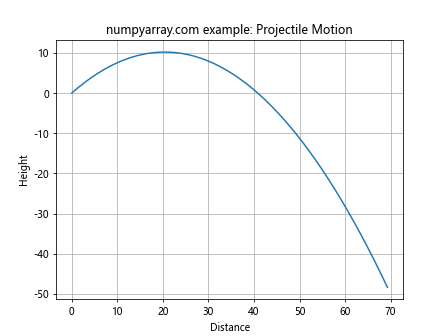
这个例子模拟了一个物体的抛物线运动。
结论
numpy.arange()函数是NumPy库中一个强大而灵活的工具,用于创建等差数列数组。它在科学计算、数据分析、机器学习等多个领域都有广泛的应用。通过本文的详细介绍和丰富的示例,我们深入了解了arange()函数的各种用法和特性。从基本的整数序列创建到复杂的多维数组操作,从简单的数学计算到高级的数据分析应用,arange()函数都展现出了其强大的功能和灵活性。
在实际编程中,arange()函数常常与其他NumPy函数和方法结合使用,以实现更复杂的数据处理和分析任务。它的简洁语法和高效性能使其成为Python科学计算和数据分析中不可或缺的工具之一。
然而,使用arange()函数时也需要注意一些潜在的陷阱,特别是在处理浮点数时可能出现的精度问题。在这些情况下,可以考虑使用np.linspace()函数作为替代。
总的来说,掌握numpy.arange()函数的使用将极大地提高您在Python中进行科学计算和数据分析的效率和能力。无论您是数据科学家、研究人员还是软件开发者,深入理解和灵活运用这个函数都将为您的工作带来巨大的便利。
 极客笔记
极客笔记